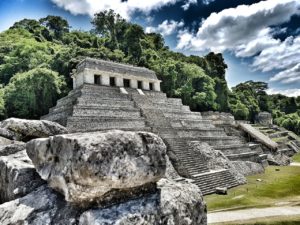
Join Dr. Anabel Ford of UC Santa Barbara’s Mesoamerican Research Center to journey through three countries of Mesoamerica, exploring one of the world’s greatest monumental ancient civilizations — the ancient Maya. See the iconic sites of Tikal, Calakmul, Palenque, among other well-known sites, including a unique exploration of El Pilar, a major Maya city where visitors can walk by monuments on paths enshrouded in the forest and where research programs are revealing how the ancient Maya practiced sustainable agricultural strategies.
In contrast with other tours of the Maya forest, this mega-trip will include visits to no less than 15 archaeological sites over 15 days, so it will be archaeologically immersive! This experience will also introduce you to the distinctive research that Dr. Ford* has conducted on the conservation of ancient Maya monuments, and a unique Maya practice of sustainable agriculture known as the Milpa Forest Garden. You will also meet local community members and see how the legacy of the ancient Maya past lives on today in its people.
See the itinerary below. Individuals who are interested in participating in this travel opportunity should email Dan McLerran at populararchaeology@gmail.com. More information will be provided when the program has been finalized.
The Itinerary
Day 1: Arrive at the Philip Goldson International Airport near Belize City and transfer to settle into your hotel in the Corozal Region with a Welcome Dinner, where your Tour Director and the tour expert Dr. Anabel Ford will go over the goals and logistics of the fascinating trip ahead of you.
Day 2: 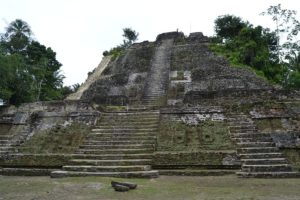 Next, travel by deluxe motor coach and boat to the monumental ancient city of Lamanai. Your local guide will walk you through the imposing structural remains, including the Mask Temple, the Jaguar Temple, and the High Temple. This city was occupied for over three millennia, beginning in the Early Preclassic Maya period and continuing through the Spanish and British Colonial periods, and even into the 20th century with Central American refugee resettlement. The Classic monuments of Lamanai were neglected like other Maya cities, yet archaeological research show that it was a vital occupation at the time of the brutal Spanish contact. Your breakfast, lunch and dinner will be included on this day.
Next, travel by deluxe motor coach and boat to the monumental ancient city of Lamanai. Your local guide will walk you through the imposing structural remains, including the Mask Temple, the Jaguar Temple, and the High Temple. This city was occupied for over three millennia, beginning in the Early Preclassic Maya period and continuing through the Spanish and British Colonial periods, and even into the 20th century with Central American refugee resettlement. The Classic monuments of Lamanai were neglected like other Maya cities, yet archaeological research show that it was a vital occupation at the time of the brutal Spanish contact. Your breakfast, lunch and dinner will be included on this day.
Day 3: Your local guides will spend a combined time of one full day to explore the monumental remains of ancient Cerros,located on a distant coastal point, and Santa Rita within the town. Santa Rita, anciently known as Chetumal, had its beginning as much as 4,000 years ago, but flourished most notably in the Postclassic period, when many other cities of the Classic Maya declined. The ancient center of Cerros is dated to the Preclassic and endured to the Postclassic period, but saw its zenith in the Late Preclassic. Enjoy the view of the Bay and the Caribbean from here! Your breakfast, lunch and dinner will be included on this day.
Day 4: We will spend a full day of travel as we make our way by private motor coach to the Chetumal region of Mexico, crossing the border and then shortly to our hotel destination where we will relax in the evening. Breakfast and dinner are both included on this day.
Day 5: Today in Chetumal we will visit the Museum of Maya Culture, which features multi-media exhibits on the history, culture and accomplishments of the Mayas. After lunch, we will visit the famous Fort San Felipe Bacalar. The beautifully preserved small Spanish fort is over 270 years old and is surrounded by a moat. It is known for its spectacular canons and ramparts, and also features a museum with artifacts, murals and interactive exhibits. Enjoy a free evening afterwards in Chetumal. Breakfast is included on this day.
Day 6: 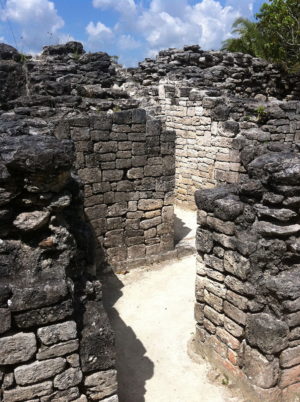 Today we depart early for the Mexican state of Campeche. On our way, we will stop at the archaeological sites of Dzibanche and Kohunlich. Dzibanche was a large city and is now thought to have been the early capital of the Kan dynasty, which later ruled from the city of Calakmul. The hieroglyphic stairway at Dzibanche features the earliest known use of the Kan dynasty emblem glyph, dated to AD 495. Kohunlich, a large site where most of the mounds still remain unexcavated, was settled by 200 BC. Kohunlich was a regional trade center and is best known for its Temple of the Masks, an Early Classic pyramid whose central stairway is flanked by huge humanized stucco masks. Breakfast, lunch and dinner are included on this day.
Today we depart early for the Mexican state of Campeche. On our way, we will stop at the archaeological sites of Dzibanche and Kohunlich. Dzibanche was a large city and is now thought to have been the early capital of the Kan dynasty, which later ruled from the city of Calakmul. The hieroglyphic stairway at Dzibanche features the earliest known use of the Kan dynasty emblem glyph, dated to AD 495. Kohunlich, a large site where most of the mounds still remain unexcavated, was settled by 200 BC. Kohunlich was a regional trade center and is best known for its Temple of the Masks, an Early Classic pyramid whose central stairway is flanked by huge humanized stucco masks. Breakfast, lunch and dinner are included on this day.
Day 7: 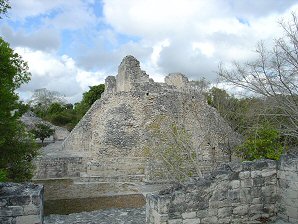 Today we will visit — count them — three ancient Maya centers: Becan, Xpuhil, Chicana, and the historic town of Zoh Laguna. Becan was occupied as early as about 550 BC, and became a major population center in the Late Preclassic. Notably, substantial earthworks and ramparts were constructed around the city. Becan was neglected by about 1200. Xpuhil, occupied between 300 and 1200 AD, was settled in the Early Classic period, although most of the structures and artifacts found at the site are dated to the end of the Classic period. Xpuhil is known for its “false” temples, structures that are not functional but serve as as living performance spaces and unclimbable stairways. Breakfast, lunch and dinner are included on this day.
Today we will visit — count them — three ancient Maya centers: Becan, Xpuhil, Chicana, and the historic town of Zoh Laguna. Becan was occupied as early as about 550 BC, and became a major population center in the Late Preclassic. Notably, substantial earthworks and ramparts were constructed around the city. Becan was neglected by about 1200. Xpuhil, occupied between 300 and 1200 AD, was settled in the Early Classic period, although most of the structures and artifacts found at the site are dated to the end of the Classic period. Xpuhil is known for its “false” temples, structures that are not functional but serve as as living performance spaces and unclimbable stairways. Breakfast, lunch and dinner are included on this day.
Day 8: 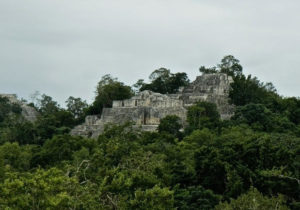 Our guide will afford us an entire day to explore the great ancient city of Calakmul which, along with Tikal, was one of the ancient Maya’s most significant power centers. Calakmul and Tikal were known to be great ancient rivals, fighting each other for regional control. Calakmul was the seat of the ‘Kingdom of the Snake.’ The Snake Kingdom reigned during most of the Classic period and the city is thought to have had a population of 50,000, wielding influence at some times over other centers as distant as 150 kilometers. Consisting of 6,750 identified structures, the largest is the massive Structure 2 pyramid, which is over 148 ft high, among the tallest and largest of the Maya pyramids. Breakfast, lunch and dinner are included on this day.
Our guide will afford us an entire day to explore the great ancient city of Calakmul which, along with Tikal, was one of the ancient Maya’s most significant power centers. Calakmul and Tikal were known to be great ancient rivals, fighting each other for regional control. Calakmul was the seat of the ‘Kingdom of the Snake.’ The Snake Kingdom reigned during most of the Classic period and the city is thought to have had a population of 50,000, wielding influence at some times over other centers as distant as 150 kilometers. Consisting of 6,750 identified structures, the largest is the massive Structure 2 pyramid, which is over 148 ft high, among the tallest and largest of the Maya pyramids. Breakfast, lunch and dinner are included on this day.
Day 9: 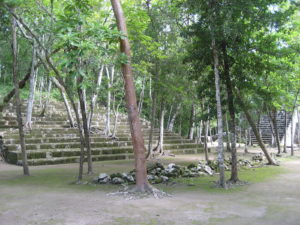 Today we make our way to Palenque, the ancient city dubbed by some scholars as the ‘Athens’ of the ancient Maya. On our way, we will stop to visit the Balamku archaeological site not far from the entrance to Calakmul. Although Balamku is a small site, it features elaborate plaster facades dating to the Early Classic period discovered when looters were apprehended. It is known for having one of the largest surviving stucco friezes in the Maya world. First occupied in about 300 BC, its most important buildings date from AD 300–600. Breakfast, lunch and dinner are included on this day.
Today we make our way to Palenque, the ancient city dubbed by some scholars as the ‘Athens’ of the ancient Maya. On our way, we will stop to visit the Balamku archaeological site not far from the entrance to Calakmul. Although Balamku is a small site, it features elaborate plaster facades dating to the Early Classic period discovered when looters were apprehended. It is known for having one of the largest surviving stucco friezes in the Maya world. First occupied in about 300 BC, its most important buildings date from AD 300–600. Breakfast, lunch and dinner are included on this day.
Day 10: We spend the entire day at Palenque, which boasts some of the most beautiful architecture, sculpture, and roof combs and bas-relief carvings of the Maya world. Scholars have reconstructed the history of Palenque through decipherment of the hieroglyphic inscriptions on its monuments, such that historians now have a long sequence of the ruling dynasty of Palenque in the 5th century, including extensive knowledge of the city’s rivalry with other states such as Calakmul and Toniná. Palenque is known for its ruler K’inich Janaab Pakal, or Pacal the Great, whose famous spectacular tomb was found and excavated in the Temple of the Inscriptions. The Museum of Palenque, which we will visit, provides a remarkable experience for understanding this tomb.
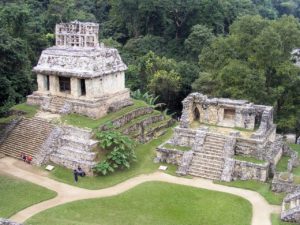
As with all of the sites we are visiting, it is estimated that less than 10% of the city’s total area has been exposed, with more than a thousand structures still enshrouded by the surrounding jungle.
Breakfast, lunch and dinner are included on this day.
Day 11: We will spend a full day of travel as we make our way by private motor coach to the Tikal region in Guatemala, crossing the border from Mexico and eventually to our hotel destination where we will relax in the evening. This trip will traverse south of the Lacandon forest and cross the Usumacinta River near Tenosique, across the savannas into the Lake Peten Itza area. Breakfast, lunch and dinner are all included on this day.
Day 12: We will spend a full day exploring the magnificent city of ancient Tikal, including the causeways, great plaza, central acropolis, ball courts and the towering temples that afford views of the vast Maya forest. We will also make time for the museums. Tikal was the capital of one of the most powerful kingdoms of the ancient Maya. Monumental architecture dates back to the 4th century BC, but the city reached its zenith during the Classic Period, from c. 200 to 900 AD. It was during this time that Tikal dominated much of the Maya region politically, economically, and militarily, while also interacting with the greater Mesoamerican sphere, including Teotihuacan in the Valley of Mexico.
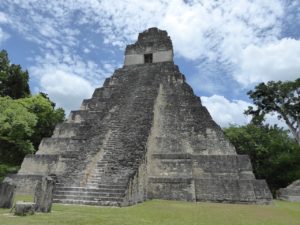
Tikal declined at the end of the Late Classic Period, and was neglected from the 10th century AD. Breakfast, lunch and dinner are included on this day.
Day 13: Today the group will transfer back into Belize for a stay in the Cayo District, stopping en route to tour the monuments at Yaxha and Topoxte Island. Yaxha was founded in the Middle Preclassic period (c. 1000–350 BC), and grew to become a large city in the eastern Petén lakes region during the Late Preclassic (c. 350 BC – AD 250), expanding further during the Early Classic (c. AD 250–600).
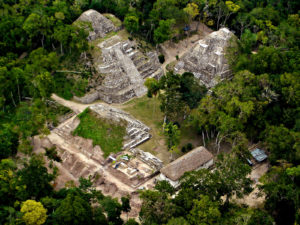
Evidence suggests that Yaxha was also influenced by Teotihuacan during the Early Classic with a stela representing the goggle eyes of Tlaloc. The city thrived into the Terminal Classic (c. 800–900). By the Postclassic period (c. 900–1525), focused attention was at Topoxte, located on islands on Yaxha Lake. Tppoxte was the capital of the Kowoj Maya, linked in rivalry to Noh Petén, on the island of Flores. Breakfast, lunch and dinner are all included on this day.
Day 14: 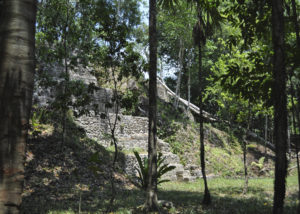 Today the group will visit the El Pilar archaeological site. Here you will be able to compare your experiences of the great Maya world to a new alternative: Archaeology Under the Canopy. With a construction chronology that dates from at least 800 BCE to 1000 CE, the site is among the largest in the local area. At El Pilar, trails wander beneath the jungle cover, beckoning you past temples, inviting you to linger across open plazas, and tempting you around houses. On the archaeological trails at El Pilar, efforts were made to feature the exquisite flora and encourage you to enjoy the fauna.
Today the group will visit the El Pilar archaeological site. Here you will be able to compare your experiences of the great Maya world to a new alternative: Archaeology Under the Canopy. With a construction chronology that dates from at least 800 BCE to 1000 CE, the site is among the largest in the local area. At El Pilar, trails wander beneath the jungle cover, beckoning you past temples, inviting you to linger across open plazas, and tempting you around houses. On the archaeological trails at El Pilar, efforts were made to feature the exquisite flora and encourage you to enjoy the fauna.
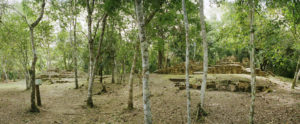
Image courtesy Macduff Everton
Day 15: The integral Maya forest garden: It is a common belief that the milpa fields destroyed the forests. New studies, however, show that the forest today was shaped by sustainable practices developed by the ancient Maya millennia ago. The ancient Maya both maintained the environment and utilized it for food, shelter, and medicine. The practice of milpa, a sophisticated and sustainable sequence that alternates between cultivated fields and forest gardens, builds a landscape of useful plants that contribute to the biodiversity of the forest. Contemporary Maya forest gardeners maintain the forest as a garden through the practices of their ancestors. We will have a chance to visit a working forest garden, the ChakHaKol of master forest gardener Narciso Torres. He will also share his vision for the school garden. You will learn how the Forest Garden contributes to action on climate change by:
1. Reducing temperature
2. Increasing biodiversity
3. Conserving water
4. Building fertility; and
5. Reducing erosion
…….and caring for people
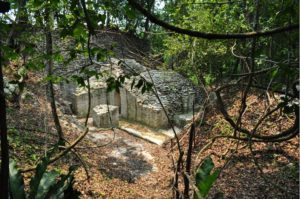
Day 16: We visit the Belize Zoo and Tropical Education Center with a local guide. The Belize Zoo is home to more than 175 animals of about 48 species, all native to Belize. The zoo differs from most other typical zoos in that the natural environment of Belize is left entirely intact within the zoo. The dense, natural vegetation is separated only by gravel trails through the forest. The zoo’s goal is to educate visitors about the wildlife of Belize through encountering the animals in their natural habitat. Breakfast and dinner are included on this day.
Day 17: We transfer to the airport in Belize City to depart for home. Breakfast is included.
___________________________
It is estimated at this point that the tour cost will range between $4,500 and $5,000 per person, double occupancy, land trip. A single room will add between $850 and $900. Airfare could add about $1,000, more or less, depending upon the person’s departure point.
If 14 or more individuals participate in this travel opportunity, Popular Archaeology Magazine will be donating funds toward the research and programs related to El Pilar and the Maya Forest Garden. Thus, your participation will constitute an important contribution to the development and sustenance of these programs.
Individuals who are interested in participating in this travel opportunity should email Dan McLerran at populararchaeology@gmail.com. More information will be provided when the program has been finalized.
*About Dr. Ford
Dr. Anabel Ford has decoded the ancient Maya landscape by combining archaeological research with traditional Maya knowledge. Ford distinguished herself in Mesoamerican archaeology with the study of patterns of settlement and environment, demystifying traditional views of the ancient Maya by examining the common human aspects of this civilization that shed light on sustainable farming practices. This forms the foundation for her current inquiries.
Ford is recognized for her rediscovery of the ancient Maya city center of El Pilar, on the contemporary divide of Belize and Guatemala, which she has transformed into a living museum and laboratory. El Pilar has become a familiar and innovative archaeological site practicing “Archaeology Under the Canopy” — using the landscape as a tool of conservation. Monuments covered with sweet moss and draped with Ramon trees make a striking and unique Maya experience. El Pilar is a model of synergy between nature and culture and is where Ford’s focus on cultural ecology — the multifaceted relationships of humans and their environment—is being applied to benefit contemporary populations. The co-evolution of human societies and the environment bring particular relevance to the study of Maya prehistory.
At El Pilar, Ford is advancing programs that simulate “Maya Forest Gardens” as an alternative to conventional monocrop farming. Using anthropology as a springboard for interdisciplinary research, she proposes that ancient traditions are yielding contemporary solutions for the Maya forest of Belize, Guatemala, and Mexico.
____________________________
El Pilar: Preserving the Maya Legacy from UC Santa Barbara on Vimeo.
____________________________
____________________________
Advertisement





